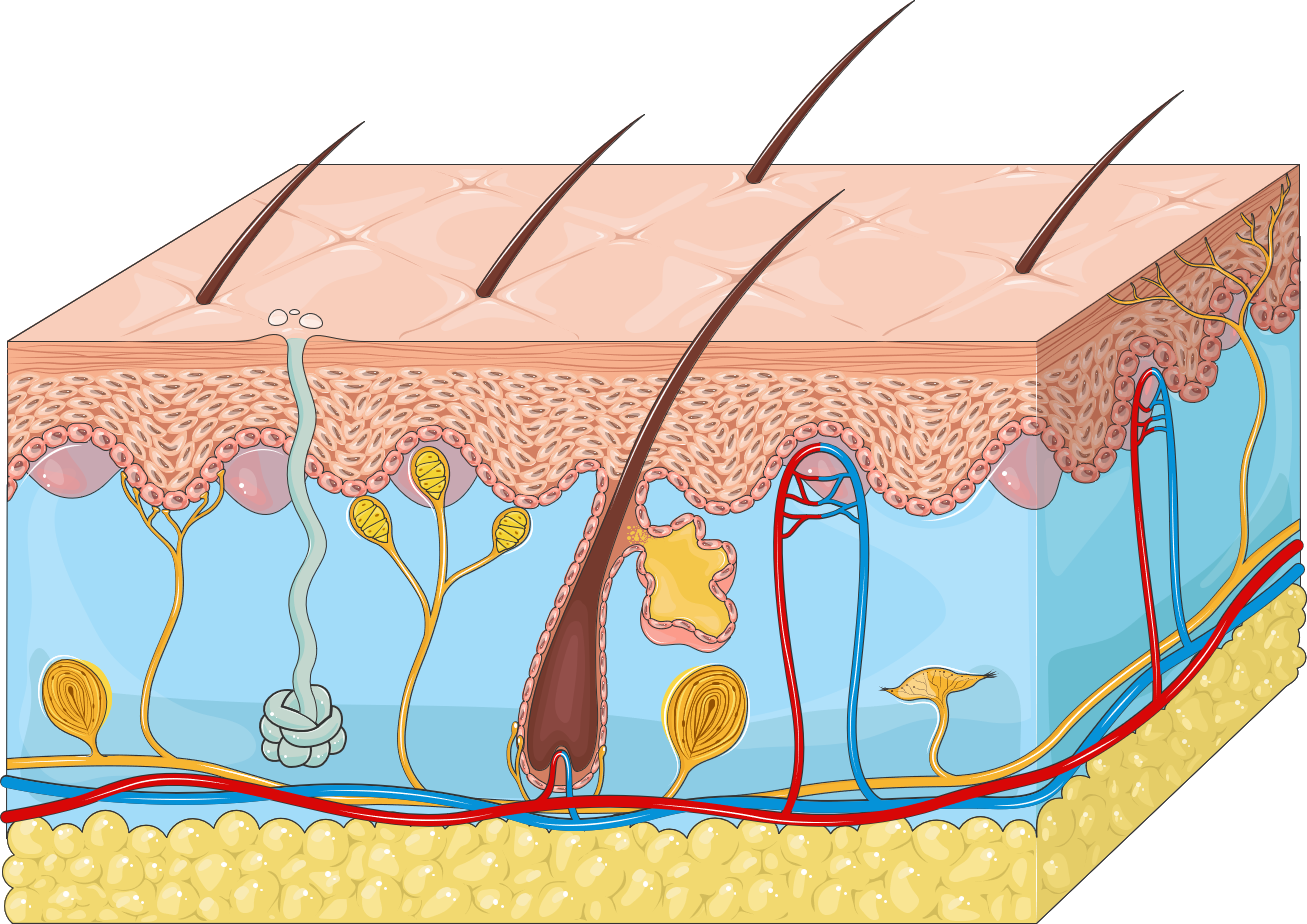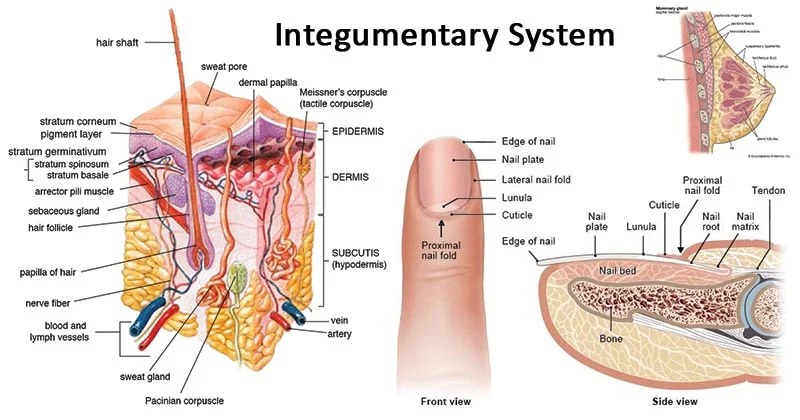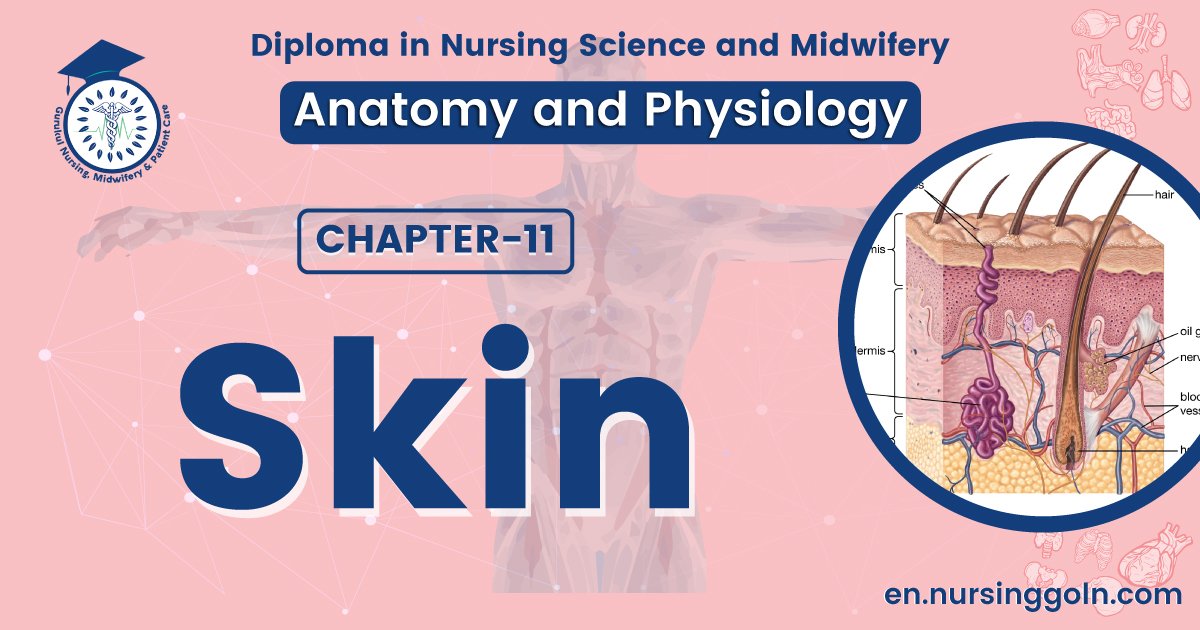Concept about Skin-The course is designed for the basic understanding of anatomical structures and physiological functions of human body, musculoskeletal system, digestive system, respiratory system; cardiovascular system; urinary system, endocrine system, reproductive system, nervous system, hematologic system, sensory organs, integumentary system, and immune system.The aim of the course is to acquire knowledge and skills regarding anatomy and physiology.
Concept about Skin

The skin or cutaneous membrane covers the external surface of the body. It is the largest organ of the body in surface area and weight. In adults, the skin covers an area of about 2 square meters (22 square feet) and weighs 4.5-5 kg (10-11 lb), about 16% of total body weight.
Structure of Skin
Structurally, the skin consists of two main parts,
- Epidermis
- Dermi
1. Epidermis: The superficial, thinner portion, which is composed of epithelial tissue, is the epidermis (epi = above),
2. Dermis: The deeper, thicker connective tissue portion is the dermis.
Deep to the dermis, but not part of the skin, is the subcutaneous (subQ) layer. Also called the hypodermis (hypo = below), this layer consists of areolar and adipose tissues. Fibers that extend from the dermis anchor the skin to the subcutaneous layer, which, in turn, attaches to underlying tissues and organs.
The subcutaneous layer serves as a storage depot for fat and contains large blood vessels that supply the skin. This region (and sometimes the dermis) also contains nerve endings called lamellated (pacinian) corpuscles that are sensitive to pressure.

Functions of skin
Following are the major functions of the skin:
1. Body temperature regulation
The skin contributes to the homeostatic regulation of body temperature by liberating sweat at its surface and by adjusting the flow of blood in the dermis. In response to high environmental temperature or heat produced by exercise, sweat production from eccrine sweat glands increases, the evaporation of sweat from the skin surface helps lower body temperature.
In addition, blood vessels in the dermis of the skin dilate (become wider); consequently, more blood flows through the dermis, which increases the amount of heat loss from the body. In response to low environmental temperature, production of sweat from eccrine sweat glands is decreased, which helps conserve heat.
Also, the blood vessels in the dermis of the skin constrict (become narrow), which decreases blood flow through the skin and reduces heat loss from the body.
2. Protection
Keratin in the skin protects underlying tissues from microbes, abrasion, heat, and chemicals, and the tightly interlocked keratinocytes resist invasion by microbes. Lipids released by lamellar granules inhibit evaporation of water from the skin surface, thus protecting the body from dehydration.
Oily sebum prevents hairs from drying out and contains bactericidal chemicals that kill surface bacteria. Hair and nails also have protective functions.
3. Cutaneous sensations
Cutaneous sensations are those that arise in the skin. These include tactile sensations-touch, pressure, vibration, and tickling as well as thermal sensations such as warmth and coolness. Another cutaneous sensation, pain, usually is an indication of impending or actual tissue damage.
4. Excretion and absorption
The skin normally has a small role in excretion, the elimination of substances from the body, and absorption, the passage of materials from the external environment into body cells.
5. Synthesis of vitamin D
Exposure of the skin to ultraviolet radiation activates vitamin D. Ultimately, vitamin D is converted to its active form, a hormone called calcitriol, that aids in the absorption of calcium and phosphorus from the gastrointestinal tract into the blood.
(Ref– J. TORTORA, 8th edition, P-101-108)

Shortly :-
Functions of skin
- Skin functions include body temperature regulation, protection, sensation, excretion and absorption, and synthesis of vitamin D.
- The skin participates in body temperature regulation by liberating sweat at its surface and by adjusting the flow of blood in the dermis
- The skin provides physical, chemical, and biological barriers that help protect the body.
- Cutaneous sensations include tactile sensations, thermal sensations, and pain.
Read more:
